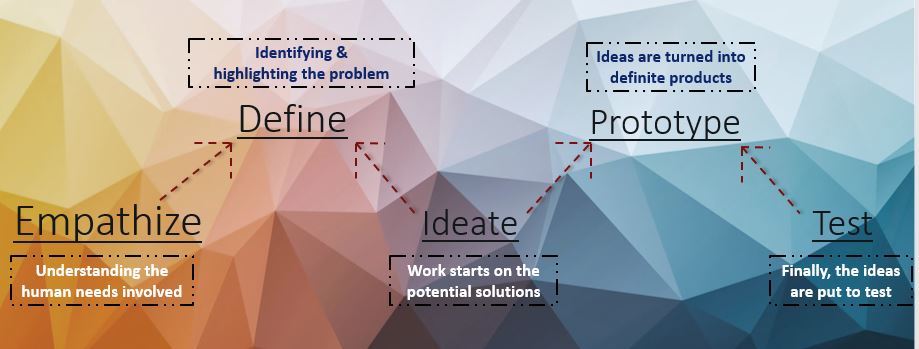What exactly is Design Thinking?
Design Thinking is a practical and creative problem-solving school of thought that takes a solution-based approach. Moreover, it is an iterative process that does not have to take place sequentially, i.e., it is non-linear.
This teaching methodology prepares students for the world outside of classes and school. Thus, they solve real-life cases through brainstorming, group analysis, creative solutions, and original ideas. This arouses their curiosity, imagination, and analytical skills.
What is the Design Thinking Approach/ Procedure?
The Design Thinking approach imbibes confidence within students in their abilities to adapt and face new hurdles. They also become capable of coming up with creative solutions to the questions they are faced with.
MBA training and Masters classes often employ this approach to teaching in order to examine actual past cases experienced by various companies. Some examples of big-league design-led corporations include Apple, IBM, Pepsi, Nike, Procter & Gamble, et al.
The procedures most closely associated with Design Thinking are: Empathize, Define, Ideate, Prototype, and Test. Although depending upon their application, the names of these steps may vary.
The typical steps that the Design Thinking approach employs are listed below.
1. Empathize
The first step in Design Thinking is to understand the problem using empathy, typically through user-research. This ensures that our own assumptions are set aside, leading to an objective approach towards the problem.
The best solutions come out of the best insights into human behavior.
– Hasso Plattner Institute of Design at Stanford
Step Goal: Placing yourself in the shoes of the student/user and analyzing the situation and the problem.
2. Define
The information gathered during the previous process is collated; the scattered pieces of information are arranged into a cohesive problem statement.
The analyzing of all the collected information takes place in order to define the core problem. What’s more, an actionable and relevant problem statement is defined in this step.
Step Goal: The overarching aim of this step is to discern the scope and the actual nature of the problem.
3. Ideate
In this step, the design team uses the knowledge from the previous two stages in order to come up with ideas and solutions. Additionally, these are then established through various sessions that may involve brainstorming, mind-mapping, sketching, and others.
This step combines the perception of the problem that the design team has with their imagination to come up with a broad range of ideas.
Step Goal: The aim of ideation is to generate as many varying ideas as possible.
4. Prototype
The design team works on the idea and comes up with potentially multiple solutions. Moreover, the discarding of impractical or unsustainable ideas also takes place during this stage.
A prototype may be a role-playing activity, a storyboard, a wall of sticky notes – anything the user can interact with. In the early stages, the prototype designed can be low level, requiring limited resources.
Further refinement of the prototype occurs in the succeeding stages of this step. For Example: Do the students enjoy studying using audio cues or visual cues more?
Step Goal: The aim of this process is to figure out the best possible solution to all the problems identified in the preceding steps.
5. Test
At this stage, the design team rigorously tests the solutions suggested in the previous step. This is the concluding stage of this process, but since Design Thinking is an iterative process, the solution test can be used to redefine other problems.
After this stage, the designers may return to one of the aforementioned steps and create further iterations, changes, and refinements. Moreover, based on the results of this stage, they may discard alternative solutions.
Step Goal: To check the efficiency of the prototype and to gather crucial feedback about it.
For further reading related to education methodologies, visit our blog page.
Create.Engage.Inspire















